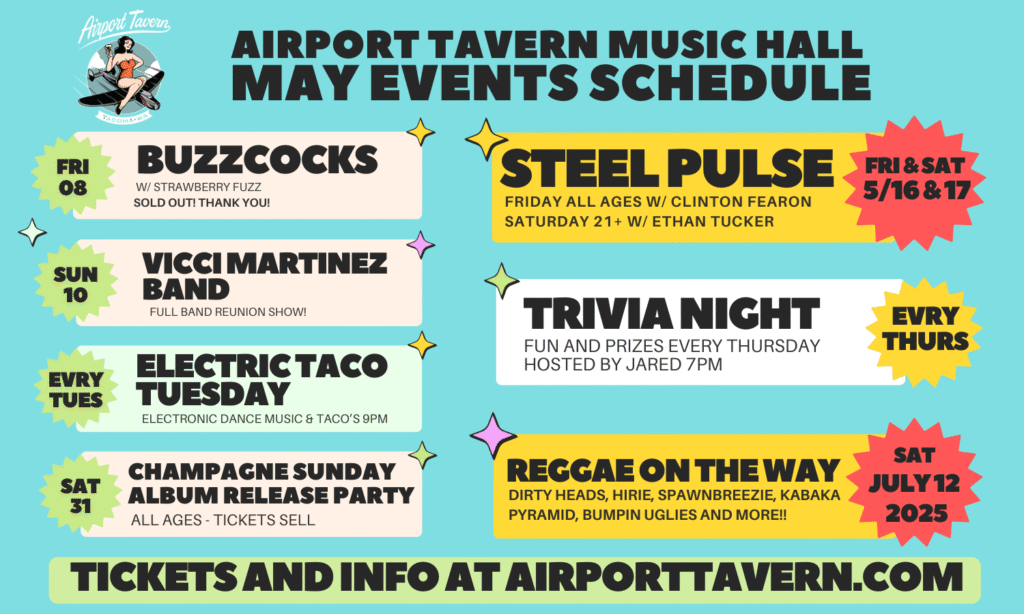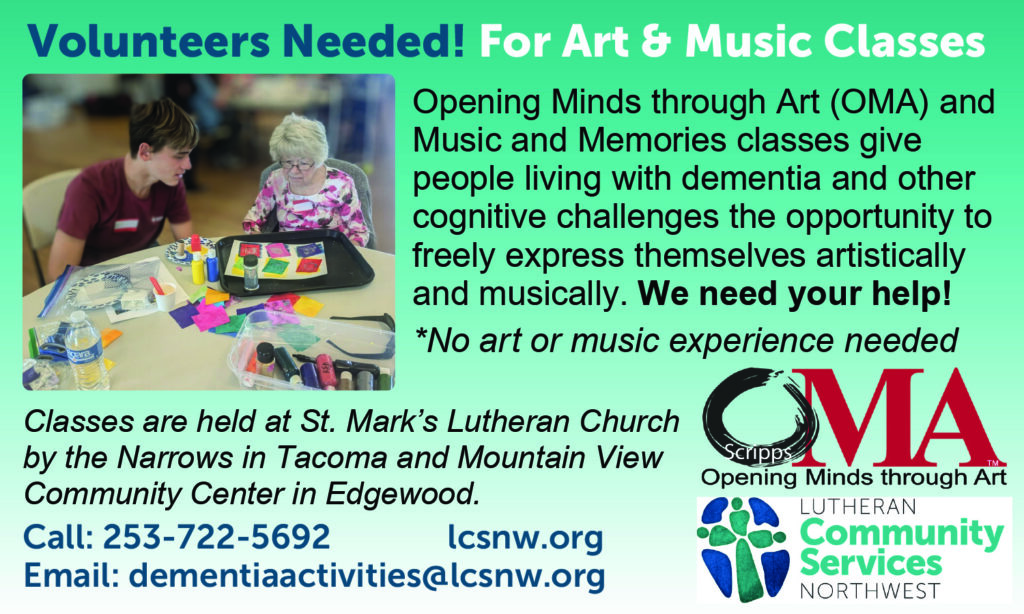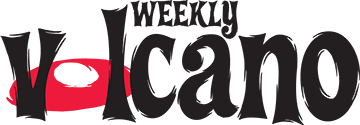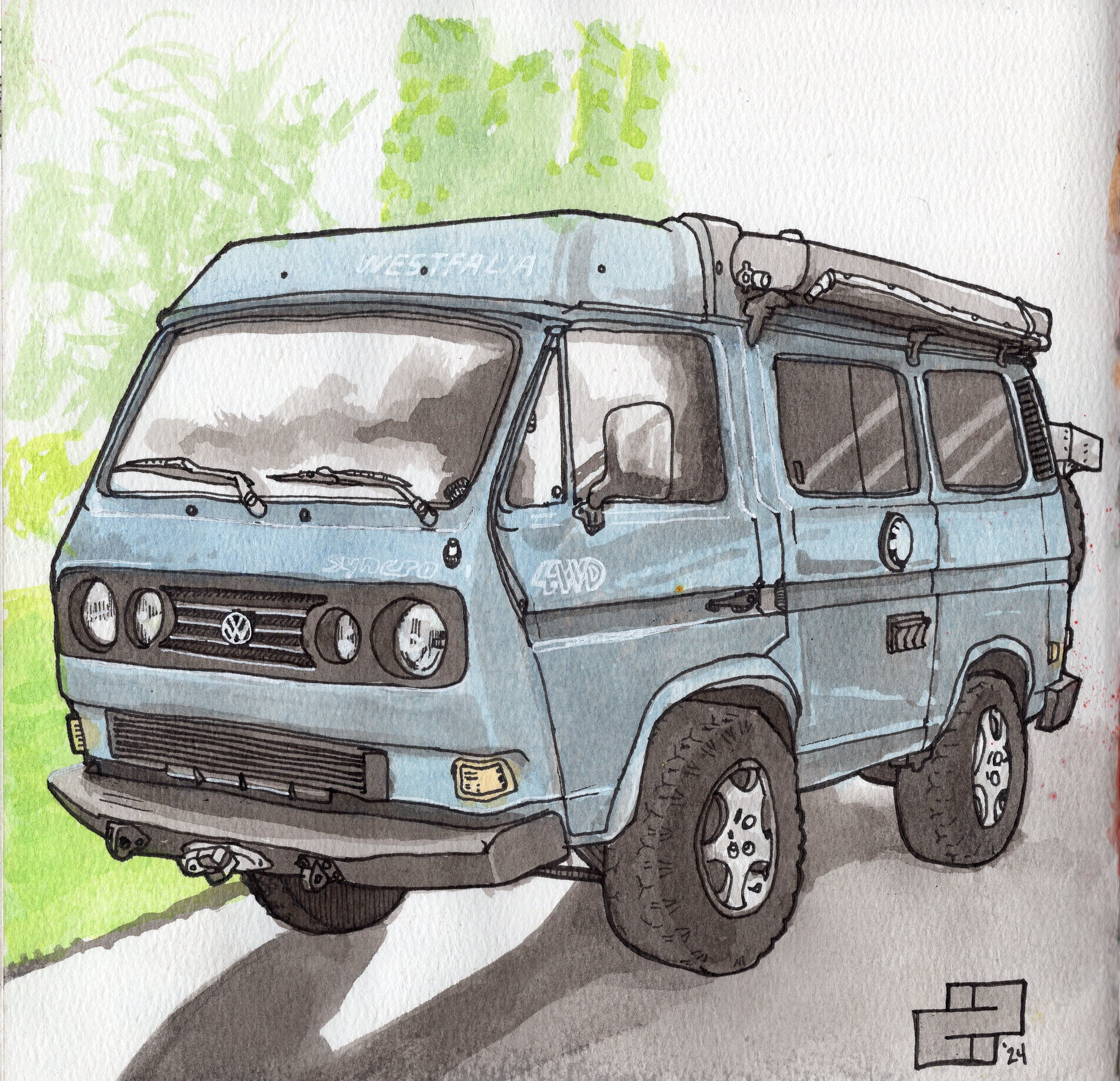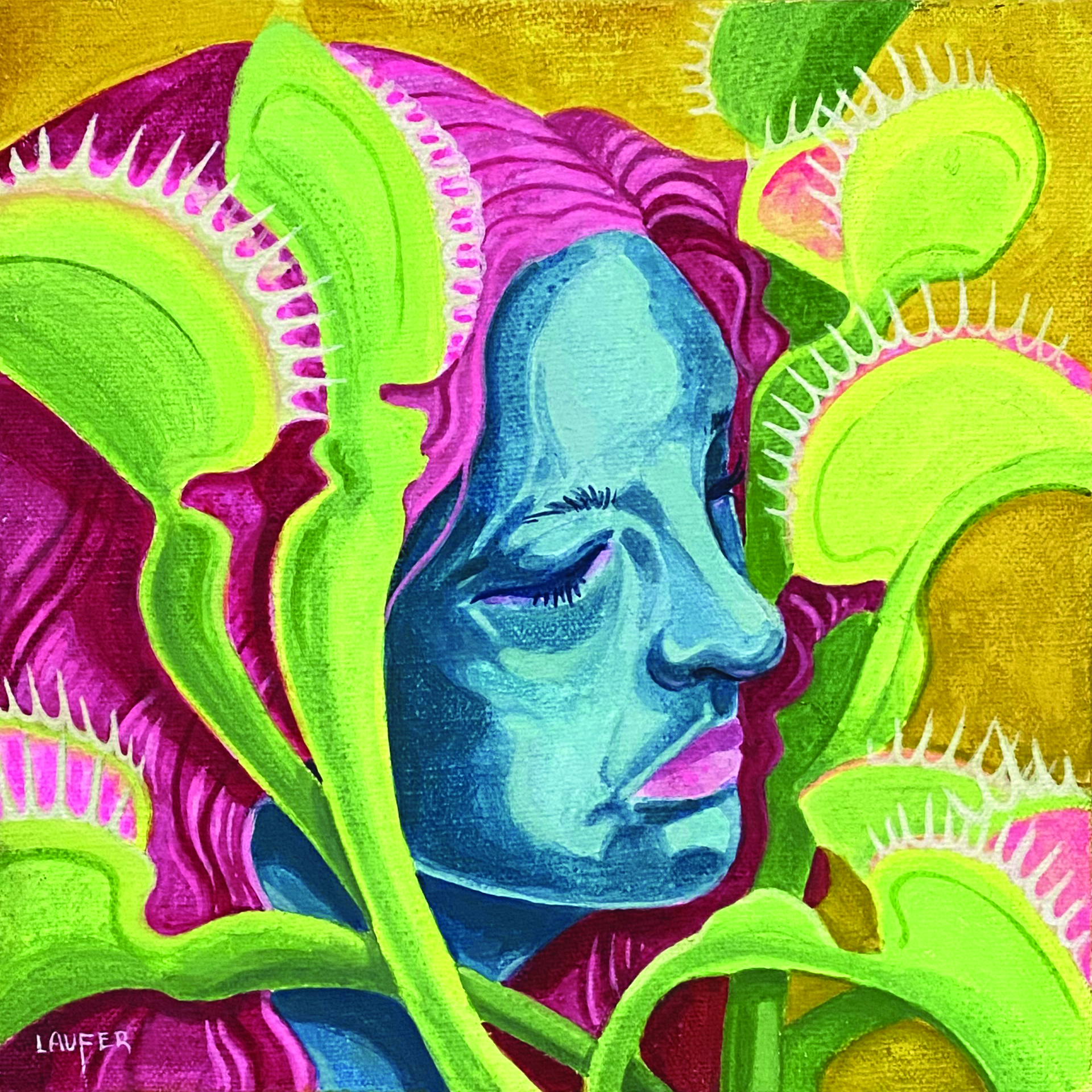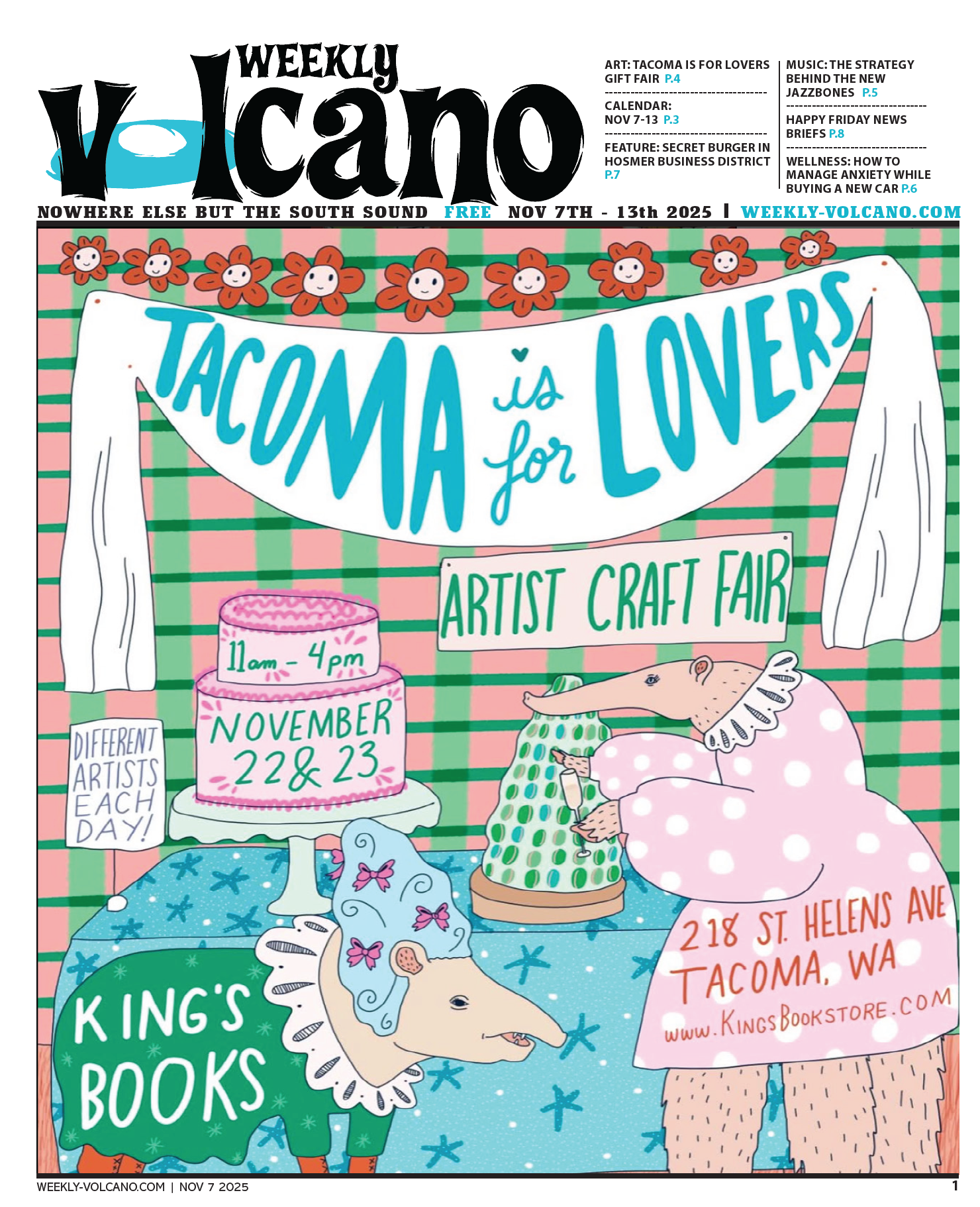BY SUZY STUMP for WEEKLY VOLCANO 5/23/25 |
When Jesse Peterson first started making art, he didn’t call himself an artist. Even after years of sketching, painting, and designing for his day job, contests, and friends, he says the label never felt quite right. “The emphasis was always more about what I make rather than who I am,” he said.
That changed when Dan Salvatora, the chef concierge at the hotel where Peterson worked, bought one of his paintings at a show at 35th North Skate Shop in Seattle. “Hey, you’re officially a paid artist now!” Salvatora told him. That moment planted the seed.
Now, Peterson is a fixture in Tacoma’s mural scene bringing color, community pride, and social consciousness to walls across the city. His work isn’t just about aesthetic appeal—it’s a visual invitation to connect, reflect, and reclaim shared spaces. Peterson describes Tacoma as a rare kind of city: one that feels both big and small, where individual actions can still make a big difference. Programs like Tacoma Environmental Services and Spaceworks Tacoma have played a crucial role in his journey.
“They offer opportunities for murals that enrich the community, celebrate cultural diversity, and encourage stewardship of our fragile ecosystem,” he said. “I’ve been lucky enough to take part in some of these programs, and I carry those themes into my work.”
His process often starts with a list—a running collection of ideas that strike him at random, whether they’re concepts he wants to share with the public or images that carry personal meaning. He begins sketching in a graph-paper notebook, then refines the composition digitally on his phone, which he refers to as his “mobile studio.” It’s a habit born of practicality: ideas can strike anywhere, and the ability to work while waiting in line or riding the train lets him stay connected to his craft. Once a design is complete, he transfers the outline to canvas or wall and brings it to life. Still life, he says, was never part of the plan.
That changed during a trip to the library with his child, where he stumbled upon Everyday Sketching and Drawing by Seattle artist Steven Reddy. Something clicked. He started a sketchbook of ink and watercolor still lifes, drawn on the spot without overthinking. “It’s the most relaxing and rejuvenating part of my creative life,” Peterson said. “Because it’s just for me. No deadlines. No stakes.”
Themes of belonging, transformation, and duality run through Peterson’s work. In one striking example, he created two versions of the same self-portrait: one vibrant and joyful, the other somber and hollow. The first was painted before he got sober; the second came three months into recovery. “It’s wild how your self-image can shift based on your choices and perspective,” he said. “I painted the happy one first, thinking it was the truth. Only later did I realize the darker one was how I had actually been feeling.”
Now sober since January 2024, Peterson says he’s never been happier. His art is deeply influenced by relationships—family, friends, mentors, and fellow artists. He credits his older brother Seth Peterson for sparking his early interest, saying Seth’s comic and sci-fi drawings were “mind blowing.” His best friend Hai Nguyen, known for his ink and watercolor paintings, helped shape Peterson’s own style and artistic humor. Other local inspirations include muralist Mindy Barker, who brought him into the mural world as her assistant, and author-artist Steven Reddy, whose book helped organize his approach to drawing. “His work gave structure to something that had been trying to emerge from me all along,” he said. Globally, Peterson points to legends like Sergio Aragones, Frank Frazetta, Simon Bisley, M.C. Escher, Sebastian Krüger, and Paul Heaston. But it’s the local community that fuels his purpose.
“Murals are for everyone,” he said. “They bypass language. They speak to values, ideas, emotion. They bring joy or provoke thought. Ideally, they create a sense of belonging.” That doesn’t mean he expects everyone to love what he paints. In fact, he’s learned to let go of the urge to impress. “I used to want people to think I was talented,” he said. “But that led to frustration and self-doubt. Now, I just try to please myself. If I love what I made, if it’s better than what I did yesterday, that’s enough.”
Still, certain reactions stand out. One came from his ex-wife, Katy, whose feedback often challenged him to push further. Another came from a friend named Pat Hertzog, who had poured countless hours into converting a camper van into a survival-ready 4×4. Peterson sketched the van in secret during a camping trip. When he showed Pat the finished drawing, the reaction was priceless. “He couldn’t believe it,” Peterson said. “It meant a lot to me—he’s someone I really admire.
Now he has a canvas print of it in his house.” Next up, Peterson is preparing six new canvas paintings for the Spaceworks Cachet fundraiser on June 7. And this summer, he’ll lead a large mural and community art project at Fern Hill Library, including yarn bombing and public painting days.
His mother, Anita, even signed up to crochet a tree sweater.
“This project is close to my heart,” he said. “We got unexpected support from the Andy Warhol and Helen Frankenthaler Foundations after our NEA grant fell through. It felt like magic.”
From filling sketchbooks to filling walls, Jesse Peterson is still figuring out what it means to call himself an artist. But in a city like Tacoma—where murals change neighborhoods and still lifes can spark friendships—his work is making a difference and that’s more than enough. Follow him @Joose253 on Instagram.
Sobriety vs. Alcoholism: A Tale of Two Portraits by Jesse Peterson
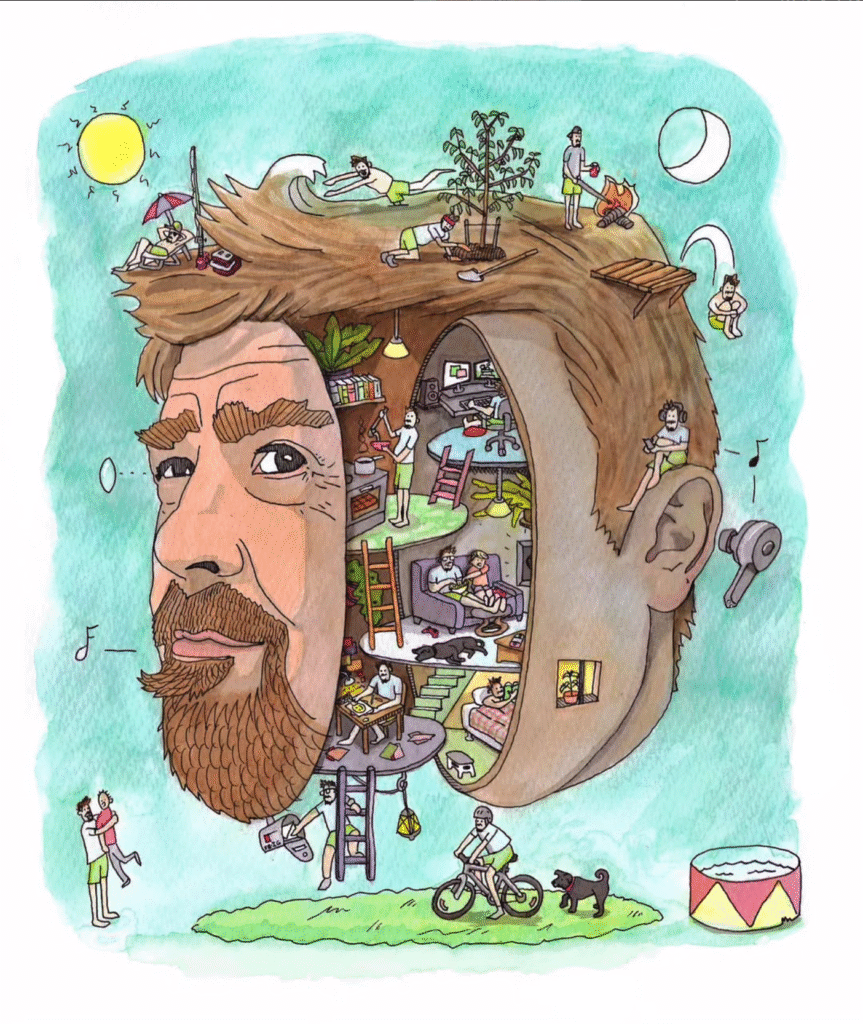
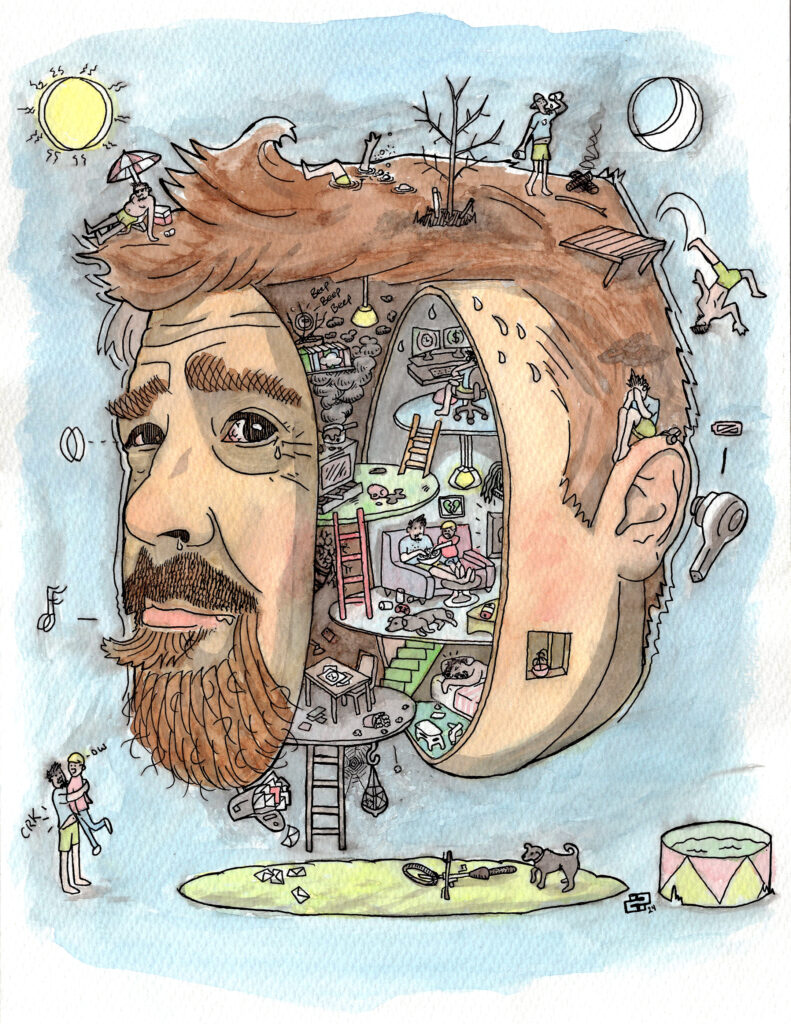
These two surreal self-portraits reflect artist Jesse Peterson’s internal contrast between sobriety and alcoholism. Each version depicts the same scenes—but through the lens of drastically different emotional and mental states. The imagery is drawn from his daily life: things he loves, habits, values, and relationships.
a. Basking in the sun by the water, fishing pole in hand, enjoying the outdoors. (Alcoholic version: passed out, sunburnt, beer nearby, no pole.)
b. Swimming in the ocean—something he insists on doing regardless of the season. (Alcoholic version: struggling to stay afloat.)
c. Planting a tree represents his pride in gardening, tending to houseplants, and nurturing life. (Alcoholic version: he’s absent; the tree and houseplants are dying.)
d. The campfire symbolizes time spent camping with loved ones, where he’s usually the designated fire-stoker. (Alcoholic version: distracted by drinking, the fire dies out.)
e. Cannonballing into a pool reflects his deep love of swimming—in any body of water. (Alcoholic version: slipping off the dock into a pool overgrown with algae.)
f. A small but symbolic contact lens—he uses them to see clearly. (Alcoholic version: distorted double vision.)
g. In the kitchen, he enjoys learning and experimenting with new dishes. (Alcoholic version: he’s gone; a pot smokes on the stove, drawers are open, the floor is messy, and the smoke alarm blares.)
h. At the computer, he taps into his passion for tech—coding, editing, animation, and more. (Alcoholic version: stressed about failed day trades and a marital separation; the icons on the screen symbolize time and money running out.)
i. Headphones represent his love of music. (Alcoholic version: the headphones are off; he’s under a rain cloud, overwhelmed by regret.)
j. His happiest place: watching movies and playing games with his son, Von, and their dog, Ripley. A framed green heart represents his ex-wife, Katy, with whom he shares a positive co-parenting relationship. (Alcoholic version: he’s still present, but the heart is broken, beer cans are scattered, and Von looks at him with quiet concern.)
k. A musical note from his mouth nods to his unusual ability to whistle five different ways. (Alcoholic version: unintelligible noise—his perception of talent warped by alcohol.)
l. Seated at the table, he draws and paints. (Alcoholic version: the space is abandoned.)
m. In bed with a book—his favorite reading spot. (Alcoholic version: passed out; the plant nearby is dead.)
n. Hugging Von and being active outdoors. (Alcoholic version: play turns too rough, causing unintentional harm.)
o. A mailbox stands for staying in touch with friends and family. (Alcoholic version: he’s disengaged; messages pile up, the lamp is broken, cobwebs gather.)
p. Riding his bike with Ripley—a shared exercise routine. (Alcoholic version: both bike and dog are left unattended.)
